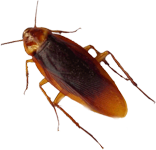

The American Cockroach
Common Name: American Cockroach Scientific Name: Periplaneta Ameriacana (Linnaeus) Class/Order/Family: Insecta/Blattodea/Blattidae Metamorphosis: Complete
Introduction
The American Cockroach is also called a "waterbug", the "Bombay canary", and the "Palmettobug". Despite its name, the American cockroach is not native to North America but was most probably introduced via ships from Africa. It is worldwide in distribution.
RECOGNITION
Adults about 1 3/8-2 1/8" (34-53 mm) long. Color reddish brown except for a submarginal pate brown to yellowish band around edge of pronotal shield. Last segment of cercus at least 2 times longer than wide. Both sexes fully winged with wings of male extending beyond tip of abdomen whereas, female's do not; poor to moderately good fliers. Nymphal early instars uniformly grayish brown dorsally, paler ventrally, shiny; cerci slender, distinctly tapered from base with length about 5 times width. Later instars reddish brown with lateral and posterior margins of thorax and lateral areas (sides) of abdominal segments somewhat darker; cerci slender, distinctly tapered with length about 5 times greatest width, widest segments 2.5 times as wide as long. Antennae uniformly brown. Ootheca or egg capsule dark reddish to blackish brown; about 3/8" (8 mm) long, with length about 1.5 times width; subdivisional furrows not extending to midwidth; weak terminal point; and usually with 8 eggs on each side.
SIMILAR GROUPS
(Adults only)
- Brown cockroach (Periplaneta brunnea) with last segment of cercus short and triangular, length less than twice width.
- Australian cockroach (P. australasiae) has front wings with outside margin at base pale yellow.
- Smokybrown cockroach (P. fuliginosa) with pronotal shield uniformly dark.
- Other cockroaches are either much smaller or larger, lack characteristic pale markings, and/or are not associated with structures.
BIOLOGY
The female deposits her ootheca within a few hours or up to 4 days after it is formed. It is dropped or glued with a mouth secretion to a suitable surface, usually in a crack or crevice of high relative humidity near a food source. On the average, the female will produce about 9-1 0 (range 6-14; maximum 90) oothecae with each containing 14-16 eggs. Developmental time (egg to adult) is greatly influenced by temperature, varying from 168-786+ days but averaging about 600 days under ordinary room conditions. During this time, they molt 10-13 times. Adult females live about 440 days (range 102-588; maximum 913) at ordinary room conditions, but at 84'F/29'C, adult females live about 225 days (range 90-706) whereas, adult males live about 200 days (range 90-362).
HABITS
Although American cockroaches are found in residences, they are much more common in larger commercial buildings such as restaurants, bakeries, grocery stores, food processing plants, hospitals, etc., where they usually infest food-storage and food- preparation areas, basements, and steam tunnels. During summer months, they can be found outdoors in yards and alleys. In the United States this is the most common species found in city sewer systems. They can enter structures by being brought in, coming up from the sewer system via drains, or occasional mass migration from other structures, dumps, etc., during warm weather. Although they feed on many kinds of food, they show a particular fondness for fermenting food.